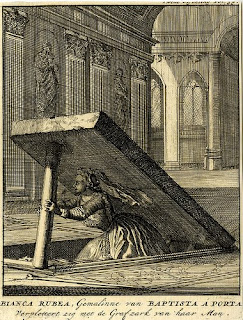My caution with regards the book started small, there were just the occasional areas that gave me pause for thought and I could actually understand why they occurred. There is an illustration in the introduction, page 12, of “‘a vampire rises from the grave…’in an 18th century illustration” . Actually, not long before receiving the book (as a Christmas present from my ever loving wife) I read an article about this illustration on the blog Diary of an Amateur Vampirologist. It seems the illustration was reproduced in Frayling’s Vampyres: Lord Byron to Count Dracula (listed in the bibliography of this) as such a piece, but it is actually of "BIANCA RUBEA, wife of BAPTISTA Á PORTA / crushes herself with the tombstone of her husband." A minor problem, as it is an illustration of a suicide and not a vampire, but I can see why Beresford believed it to be of a vampire given Frayling used it as such.I most recently dealt with this erroneously-named picture in "Hats Off to Erwin".
Taliesin also left a comment to said blog, which I'll reply to here:
I am currently reading "From Demons to Dracula" by Matthew Beresford, which so far is quite good - expect a review when read.As mentioned, I did read it. Loved it. If you're interested, you might want to check out Niels K. Petersen's coverage of it over at Magia Posthuma.
I'm sure I'll get around to obtaining a copy of the book, sometime, myself.
However, the illustration is reproduced in that with the caption "A vampire rises from the grave, from an eighteenth century illustration."Ah, yes. Nearly the exact same caption it's given in Frayling's book, Vampyres: From Lord Byron to Count Dracula (1991).
It accompanioes the introduction. Now, given Beresford cites Frayling in his bibliography, the place he picked it from is clear but, it seems, this one is likely to run and run...I'd agree that Frayling's book is the most likely source for the picture's erroneous description. The obvious clue to this is the caption that follows it in Frayling's work: "A vampire rises from the grave, illustrating an early eighteenth century treatise on the undead."
A slightly different wording to that found in Beresford's book, as you've quoted it, but recognisable, nonetheless.
I certainly hope it doesn't catch on as a picture representing an undead rising from the tomb. Though, there is certainly an irony in that description, considering that it actually depicts a woman entombing herself, certainly not rising in search of blood.
So folks, if you see this picture (chances are, with the original caption removed)...
...being referred to as anything even remotely vampiric, then dismiss it as bad research. Indeed, it's not even from the "eighteenth century", but the seventeenth. For, according to the Koninklijke Bibliotheek, the image was published in 1699.

No comments:
Post a Comment